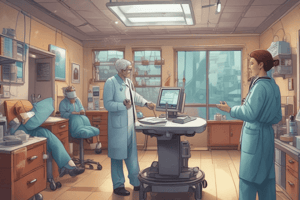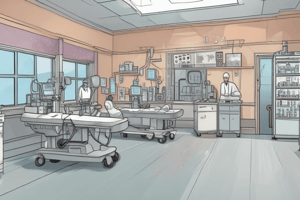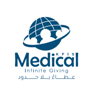Podcast
Questions and Answers
What is the basic concept of patient safety?
What is the basic concept of patient safety?
- Ensuring patient well-being (correct)
- Avoiding litigation cases
- Managing patient falls
- Preventing medication errors
Patient safety incidents are usually the fault of an individual.
Patient safety incidents are usually the fault of an individual.
False (B)
According to the World Health Organisation, how many patients in primary and outpatient health care suffer from patient safety incidents?
According to the World Health Organisation, how many patients in primary and outpatient health care suffer from patient safety incidents?
4 in 10
Unsafe acts can be described as 'Not following accepted good and safe practices', for example, not wearing ___________.
Unsafe acts can be described as 'Not following accepted good and safe practices', for example, not wearing ___________.
What does T.E.A.M.S stand for in the context of patient safety?
What does T.E.A.M.S stand for in the context of patient safety?
What are the components of system improvement in healthcare according to the provided content?
What are the components of system improvement in healthcare according to the provided content?
Safe Surgery prioritizes patient safety only during the surgical procedure itself.
Safe Surgery prioritizes patient safety only during the surgical procedure itself.
According to the content, approximately half of all adverse events experienced by hospitalised patients are directly linked to _____ care.
According to the content, approximately half of all adverse events experienced by hospitalised patients are directly linked to _____ care.
What is AMR and why is it a growing concern in healthcare?
What is AMR and why is it a growing concern in healthcare?
Which of the following are contributing factors of AMR in the healthcare setting?
Which of the following are contributing factors of AMR in the healthcare setting?
The body becomes colonized with resistant bacteria when exposed to antibiotics.
The body becomes colonized with resistant bacteria when exposed to antibiotics.
Antibiotic resistance occurs when they are ________ and ________.
Antibiotic resistance occurs when they are ________ and ________.
Match the following treatment options with their descriptions:
Match the following treatment options with their descriptions:
What is the ISBAR framework endorsed by the World Health Organisation used for?
What is the ISBAR framework endorsed by the World Health Organisation used for?
How should junior healthcare professionals respond to patient safety incidents?
How should junior healthcare professionals respond to patient safety incidents?
What is the purpose of Infection Prevention & Control (IPC)? To stop transmission by breaking the chain of ____.
What is the purpose of Infection Prevention & Control (IPC)? To stop transmission by breaking the chain of ____.
Match the following components of the chain of infection with their descriptions:
Match the following components of the chain of infection with their descriptions:
Direct contact is a common mode of transmission of infections in healthcare settings.
Direct contact is a common mode of transmission of infections in healthcare settings.
What is the estimated annual cost associated with medication errors according to the content?
What is the estimated annual cost associated with medication errors according to the content?
What percentage of prescriptions received contribute to medication errors each year?
What percentage of prescriptions received contribute to medication errors each year?
What are High Alert Medications (HAM)?
What are High Alert Medications (HAM)?
Errors in prescribing, dispensing, and administering medications can happen at any step of the medication use process.
Errors in prescribing, dispensing, and administering medications can happen at any step of the medication use process.
How can errors with High Alert Medications (HAMs) be prevented?
How can errors with High Alert Medications (HAMs) be prevented?
What should prescribers always remember before prescribing? The 3 words are KNOW, CHECK, and ___
What should prescribers always remember before prescribing? The 3 words are KNOW, CHECK, and ___
Match the factor with the type of contributing factor related to medication errors:
Match the factor with the type of contributing factor related to medication errors:
Reporting all incidents related to patient safety, including near misses, is not necessary.
Reporting all incidents related to patient safety, including near misses, is not necessary.
Patient Safety ______ reporting involves investigating or reviewing why the incident happened, learning from the incident, taking appropriate action to prevent similar incidents, and sharing with others.
Patient Safety ______ reporting involves investigating or reviewing why the incident happened, learning from the incident, taking appropriate action to prevent similar incidents, and sharing with others.
What is the purpose of a postoperative visit?
What is the purpose of a postoperative visit?
What should be confirmed before marking surgical sites?
What should be confirmed before marking surgical sites?
Junior healthcare professionals should assist in filling out the HPE request form.
Junior healthcare professionals should assist in filling out the HPE request form.
Effective communication involves clarity in both encoding and decoding the message, ensuring successful __________.
Effective communication involves clarity in both encoding and decoding the message, ensuring successful __________.
Match the following communication barrier factors:
Match the following communication barrier factors:
Flashcards are hidden until you start studying
Study Notes
Patient Safety Awareness Course for Junior Healthcare Professionals
- The course is designed to equip junior healthcare professionals with the foundational knowledge and practices to ensure patient safety.
- The course covers key concepts such as effective communication, safe surgery, infection control, and medication safety.
The Basic Concept of Patient Safety
- Patient safety incidents are costly, with an estimated global cost of RM 126 billion annually.
- In Malaysia, patient safety performance is monitored using the Malaysia Patient Safety Goals 2.0.
- In 2022, there were 8 cases of wrong surgery, 60 cases of unintended retained surgical items, 50 cases of actual blood transfusion error, and 3010 cases of actual medication error.
Burden of Patient Safety Incidents
- The World Health Organisation estimates that 4 in 10 patients in primary and outpatient healthcare suffer from patient safety incidents, and 80% of these incidents are preventable.
- In the hospital setting, it is estimated that 1 in 10 patients is harmed while receiving hospital care, and up to 50% of these incidents are preventable.
Patient Safety Culture
- Patient safety culture is defined as a framework of organised activities that create cultures, processes, procedures, behaviours, technologies, and environments in healthcare that consistently and sustainably lower risks, reduce the occurrence of avoidable harm, and make errors less likely.
- The "Swiss Cheese Model" explains how patient safety incidents occur in healthcare, with multiple levels of barriers that can fail and align to cause harm.
- Patient safety incidents are usually a symptom of a failed system rather than the fault of an individual.
Prevention of Patient Safety Incidents
- Prevention of patient safety incidents requires a collective effort and a culture of safety thinking, safe practice, safe conditions, and system improvement.
- Safety thinking involves thinking about safety at all times, and considering questions such as "do I need help?", "do I have the skills?", and "how can I make it safer?".
- Safe practice involves following policies, guidelines, and SOPs, and practising effective communication and good teamwork.
Safe Surgery
- Safe surgery is a collaborative journey that prioritises patient safety throughout the entire surgical process.
- The World Health Organisation estimates that 50% of surgical errors are preventable using a checklist.
- In Malaysia, the rate of wrong surgery is 2 per 1 million surgeries, and incidents of unintended retained surgical items still occur.
- The Safe Surgery Checklist is a systematic and comprehensive "checking system" that ensures adequate preparation of the surgery, correct and safe surgery, and correct patient identification.
Malaysian Patient Safety Goals
- The Malaysian Patient Safety Goals (MPSG) are targets set by the Ministry of Health Malaysia to improve patient safety.
- The goals include reducing the incidence of wrong surgery, unintended retained surgical items, and other patient safety incidents.
- The MPSG statistics from 2019 to 2022 showed that although progress has been made, there is still room for improvement.### Surgical Site Confirmation and Checklists
- Ensuring the correct body part or area is marked for the procedure
- Operative consent verification: checking that the patient has signed the informed consent form and that all necessary information is complete
Pre-Operative Checklist
- Filled up by the scrub nurse and circulating nurse throughout the procedure/surgery
- Ensuring swabs and instruments used are not left behind within the patient's cavity
Pre-Discharge Checklist
- Filled up by the recovery nurse and ward nurse
- Ensuring the patient is stable enough to be transferred to the ward following surgery
- Handling the operated specimen correctly (e.g., correct labelling)
Operating Team Checklist
- Involves house officers (HOs) in identifying the patient correctly, writing on the 'white board', and participating in the 'time out' with the operating surgeon and other team members
Intra-Operative Communication
- Emphasizes the importance of communication between team members during the operation
- Ensures each team member knows what is going on and updates the operation
- Includes check-in, periodic updates, shout-out, and pre-closure disclosure
Post-Operative Communication
- Sign out (debriefing) by the surgeon, summarizing operative findings and procedure
- Verifying specimen sent and labelling
- Anaesthetist discussing special post-operative instructions with the team
- Scrub nurse informing the team about the swab count
Good Practices for Junior Healthcare Professionals
- Ensure correct patient identification
- Know the patient's history and planned procedure
- Observe and understand the procedure before performing it
- Perform the procedure under supervision
- Know your limitations and get assistance if necessary
- Call for help immediately if something goes wrong
Effective Communication
- Importance of communication in healthcare: 27% of medicolegal complaints and 27% of medical malpractice cases are due to poor communication
- Effective communication concept: encode, message, decode, and feedback
- Barriers to effective communication: personal factors (language barriers, attitudes, knowledge gaps, fatigue, and stress) and environmental factors (noisy surroundings, cultural differences, and weather)
Communication in Clinical Settings
- Steps to effective communication: clarify, concise, listen, and assert
- Effective communication is a two-way street, requiring active listening and interpreting non-verbal cues
- Situations requiring effective communication: seeking consultation, referring cases, informing concerns, taking consents, breaking bad news, and communicating errors
Patient Safety Assertion Model
- Model for seeking consultation, referring cases, and informing cases
- Includes proposing an action where the communication stops at describing the problem
ISBAR Framework
- Standardized approach to communication: Introduction, Situation, Background, Assessment, and Recommendation
- Can be used in any situation, including patient safety incidents
Junior Healthcare Professionals in Effective Communication
- Best practices: proper documentation, avoiding non-standard abbreviations, and seeking help when needed
- Communicating patient safety incidents: report promptly, inform supervisor, and document all communication### Healthcare Associated Infections (HCAIs)
- Pneumonia is the most common type of HCAI, followed by Blood Stream Infections (BSIs)
- CLABSI stands for Central Line Associated Blood Stream Infection
Modes of Transmission of HCAIs
- Direct contact: person-to-person transmission through contact with mucous membranes or breaks in the skin
- Indirect transmission: through devices such as thermometers, stethoscopes, and medical devices
- Droplet transmission: through respiratory droplets carrying pathogens
- Airborne transmission: through airborne droplet nuclei
- Less common mechanisms: hematogenous seeding from another source, contaminated infusates
Preparation for Central Venous Catheter (CVC) Insertion
- Hand hygiene is crucial
- Aseptic Non-touch Technique (ANTT) is essential
- Barrier precautions for operator and patient
- Selecting the appropriate skin antisepsis (2% chlorhexidine in 70% alcohol)
- Optimal catheter site insertion
Maintaining Catheter Venous Catheter (CVC)
- Decontamination and flushing
- Proper way to collect urine specimen from continuous bladder drainage (CBD)
Aseptic and Clean Technique
- Purpose: to prevent infection
- Examples of clean technique: wearing gloves, using sterile equipment
- Examples of aseptic technique: using sterile dressing, scrubbing the hub
Antimicrobial Resistance (AMR)
- Definition: the ability of microorganisms to resist the effects of antimicrobial drugs
- Global concern: one of the top 10 global public health threats
- Impact: 1.27 million deaths in 2019, significant economic burden
- Contributing factors: misuse and overuse of antimicrobials, lack of awareness and knowledge, poor infection and disease prevention and control
- Drivers: selection pressure, transmission of resistant genes
Antimicrobial Stewardship (AMS)
- Definition: a coordinated systematic approach to improve the appropriate use of antimicrobials
- Strategies: optimizing antimicrobial use, preventing antimicrobial selection pressure
- Role of junior doctors: promoting judicious antibiotic use, making the right diagnosis, initiating right antimicrobial choice and dose
Medication Safety
- Definition: the avoidance of medication errors that can lead to patient harm
- Factors related to medication error: complex medication use, look-alike sound-alike (LASA) medications
- Importance: leading cause of injury and avoidable harm in healthcare systems
- Good prescribing practices: using computerized systems, understanding the importance of medication safety, and avoiding contributing factors to medication error
Studying That Suits You
Use AI to generate personalized quizzes and flashcards to suit your learning preferences.





